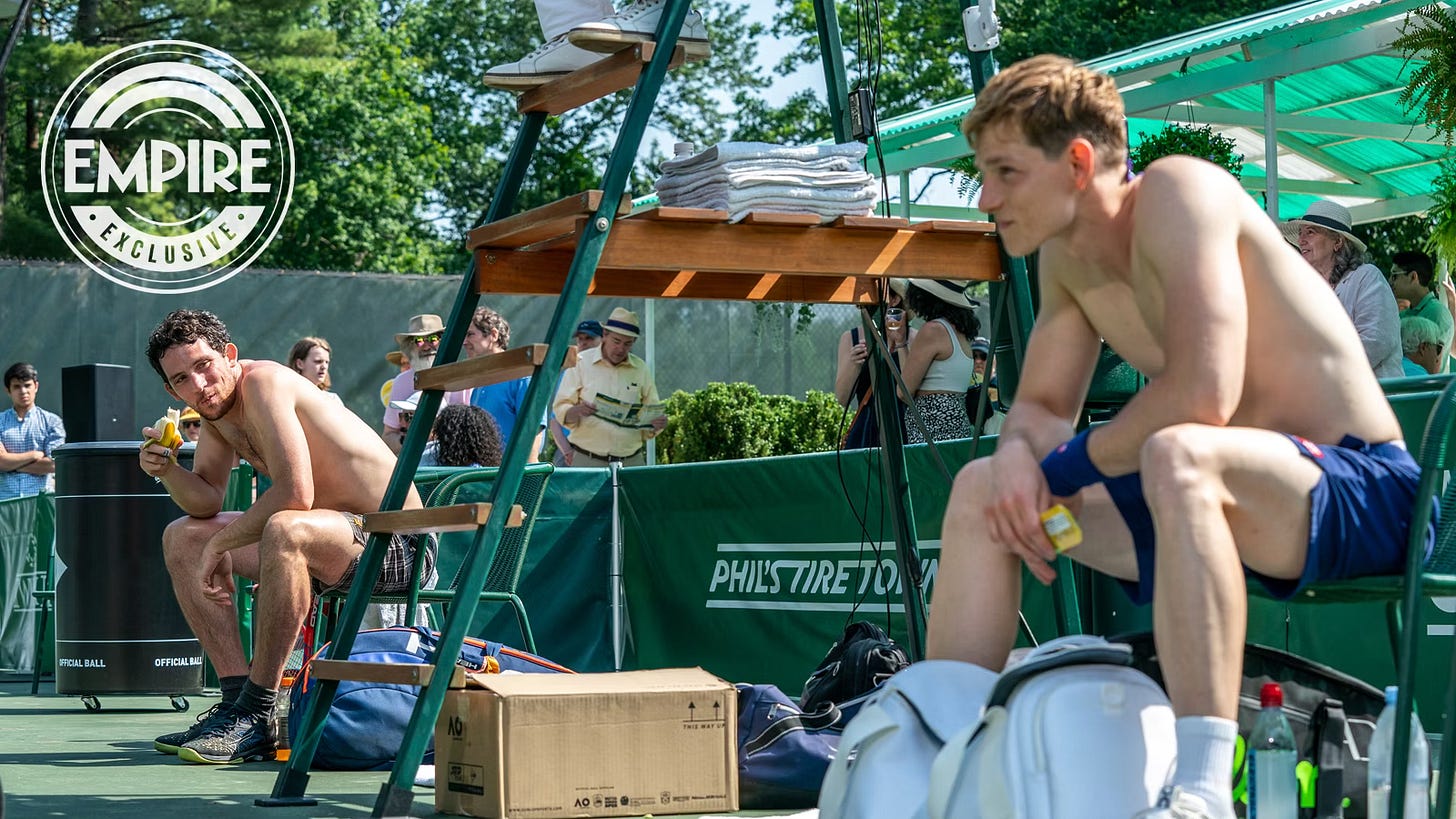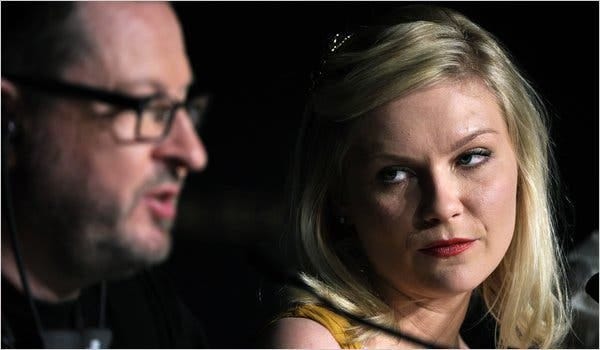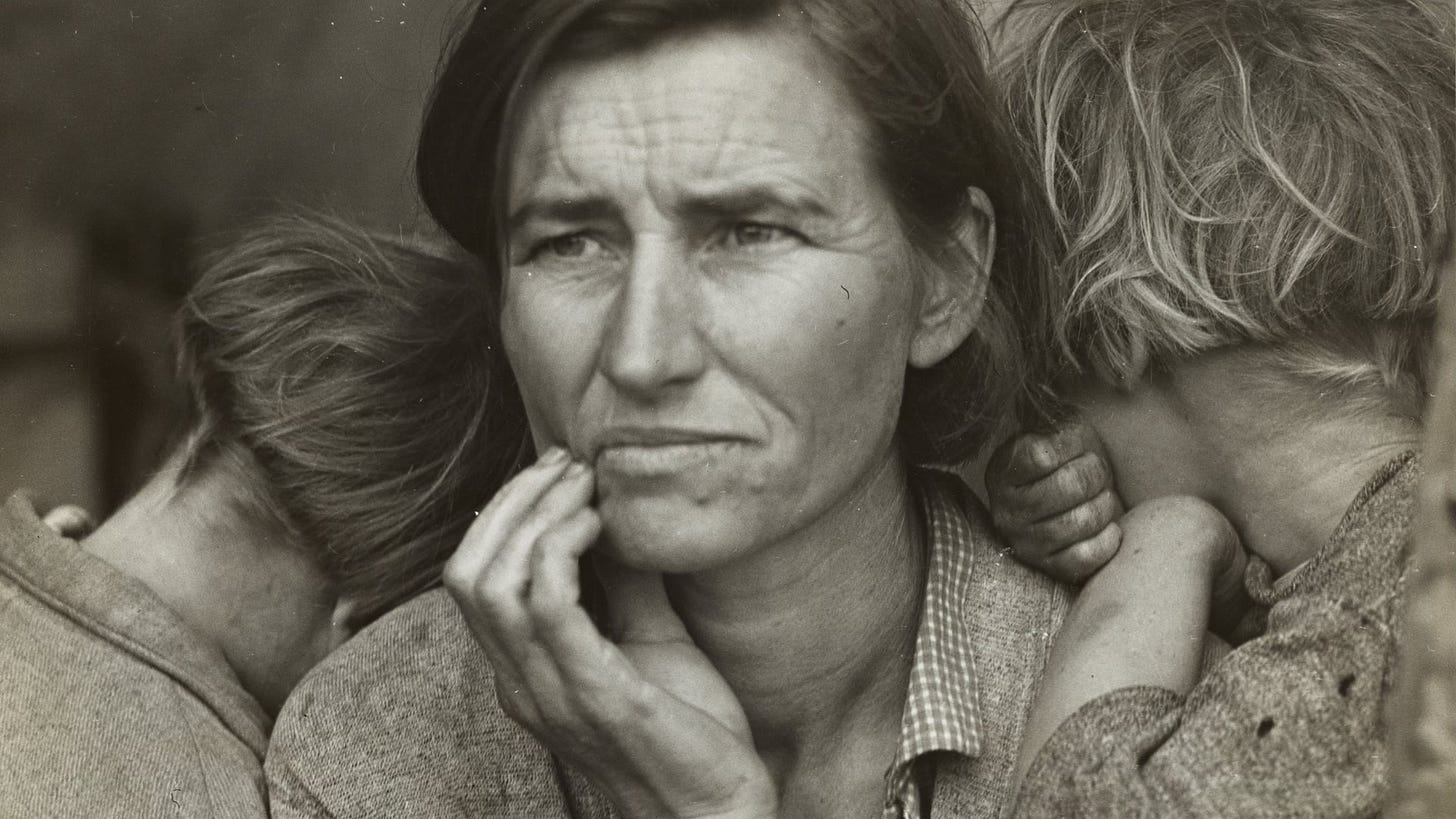Welcome to We Have to Talk, a fortnightly newsletter in which Sam and George exchange their most pressing and ridiculous reflections on pop culture. Subscribe to get a hot mess of tepid takes directly into your inbox, twice a month.
This week, George takes a Radically Pessimistic™ approach to Challengers, Sam spots a Spice Girl, and the Tortured Listeners Department lodges a complaint.
S: Hey George, what's that sound we hear? It can only be stampeding crowds of underserved adult cinephiles flocking back to the multiplexes. This last month has seen a number of thoughtful mid-budget spectacles hit the big screen, and I’m cautiously optimistic that cinema might actually be back for real. First we had Civil War, which – despite being visually marketed as a disaster film, and bizarrely promoted by its creatives as a paean to journalism – was actually about a rag-tag crew of adrenaline junkie photographers being led into the heart of the White House by an exhausted Kirsten Dunst. Bobbing and weaving past tanks, rocket fire and an alarmingly bespeckled Jesse Plemons, they finally secure the pithiest of pull quotes which only the New York Post could be proud of.
On the other side of the court, we’ve most recently had Challengers, a film about how a strong back hand is rarely amongst the most important drives in ones’ life. Like so much good drama, both films explore sublimated desires, examining how we go about getting the things we can’t admit we want, whether that’s a warzone-sourced cortisol spike or a backseat shag in an unshowered Josh O’Connor’s car. You’ve seen both films and I know our opinions diverge somewhat, so let’s get into it. What did you make of Civil War?
G: Hey, Sam. I feel like ‘movies are back’ is thrown around so much as to dilute its meaning, but I’m on board with this application in the context of the mid-budget spectacle. Civil War cost US$50m, and Challengers $55m, which is actually a little insane when you think about it; I’m assuming a significant chunk of the latter was Zendaya’s salary. Nevertheless, it’s exciting to see both films - original screenplays too - do so well critically and financially. You don’t need me reminding you that there was a plethora of these movies being released when we were kids or early teens - 20 years ago, Mean Girls made $130 million on a $17 million budget.
I was initially unsure of Civil War, but have grown to appreciate it more since I’ve sat with it. Though the ending punctured a lot of the emotional heft for me, I was interested in both its reverence and critique of journalism. I felt Garland was both reminding us of the importance of documenting conflict, but also inviting us to feel baffled, even angry, at how inhumane the act of actually doing this looked on screen. Kirsten Dunst and Cailee Spaeny hovering with their cameras while people bled out looked almost careless, which is a normal human reaction, and I think is an important tone to strike for any film about war.
Even though the audience knows reporters have a vital job to do, it seems to go against the human instinct to intervene in some way, and thus Civil War reminds us that in conflict, everyone loses. To that end, I liked that the film explored not only the cost of violence, but also the sacrifices made by both subject and photographer in documenting it. As for criticisms of its absence of politics, I’m not sure I trust Alex Garland to do that responsibly anyway.
Challengers, unfortunately, felt low on juice (deuce?) to me. I should begin by stating that when I watched it, I was inexplicably in one of the foulest moods of my life, a dreadful headspace to watch movies in: like trying a Michelin star restaurant with a burnt tongue. In that state, I was more focused on bothersome technical issues; I could have sworn Josh O’Connor used a new pronunciation for Tashi (Zendaya)’s name every time, the product placement was grating, and why was there so much fucking paper flying about in that windstorm? It looked like a filing cabinet had been dropped from a helicopter. That said, the score bangs, and it can only be a good thing that an original story starring three of our best young actors in a horny, machiavellian love triangle is doing so well.
I volley the question back to you: did Civil War and Challengers work for you?
SJ: Civil War had its faults, but really worked for me on IMAX. But I honestly can’t tell if what I got from the film was quite what was intended by its makers. While primarily along for the ride of a Kirsten Dunst press tour, I read that Garland intended to shoot a true anti-war film, presumably not one that is enamoured with the spectacle of violence, and I would question whether he really achieved that. But I thought the film’s denouement, which you didn’t like, at least laid plain the glibness of the preceding action.
I totally agree that Civil War actually seems critical of journalism. As a story of class, these are people both part of a conflict and apart from it; the swanky hotel which grounds its opening scenes and the protections which the press are offered by military personnel was writ large. But the film’s desire to be apolitical – or at least disinterested in the factional conflicts which plunged its all too recognisable near-future milieu into violence – meant it could really only provide a psychological examination of the desire to bear witness to war. The apolitical narrative limits the film’s interest in the politics of image-making too, so it feels like a film out of time in many ways. But I thought the film’s directorial choices did seem to hold some latent critiques about the waning power of singular images in the nanosecond newscycle of the digital age. Cailee Spaney’s Jessie – the audience surrogate – shoots only on black and white film, with her shots harkening back to the days of Capa, Lange and Adams; legendary 20th century photo-journalists whose iconic images shaped history and the popular imagination of it. Dunst’s Lee, meanwhile, barely shoots a frame throughout. But the visual style moved precisely between self-consciously ugly digital photography in many of the battle scenes, and more classic film styles with resplendent bokeh during the characters’ private moments, so it did seem to be proposing something in this vein, at least visually.
I’m sorry to hear you were not one-love for Challengers because I found it to be a ludicrously entertaining serve (ahem). And you’re correct about the egregious budget; Zendaya reportedly received a cool $10 million for the film, which makes me wonder what Faist’s nipples received. It felt like a perfect fit for Guadagnino to direct, as a filmmaker whose eye for visual details and characters’ self-presentation can sometimes be slightly too cool. In that way, this story of players who won’t show their entire hand is a perfect match (ahem x 2) of script and sensibility; and an indicator that Zendaya, who brought the project together as a producer, may prove to be a real Hollywood visionary in years to come. Plus, it’s just great fun to watch a talented director, top tier cast and genius choice of composers and costume designer go absolutely ham to elevate something that could have otherwise been much more stylistically unremarkable in lesser and less committed hands.
I even found the ubiquitous product placement to be a masterstroke. The relentless branding made the film feel very au courant while grounding its conceit that the world of tennis is really just an elaborate setting for powerplays, whether that be athletic, sexual, mental, or monetary. If only someone had written about how these kinds of fashion world collaborations come together (sorry!).
Anyway, speaking of power – and from racquets to rackets, I suppose – Taylor Swift is busy decimating vinyl production plants and spotify charts the world over. Any thoughts on everyone’s favourite Tortured Poet?
G: To draw a parallel with cinema, Taylor Swift feels like the music world’s equivalent of big-budget Marvel mush. (It’s also hilarious to me that she called the album Department in a presumed attempt to not be sued by the writer of Dead Poets Society, as though Taylor’s vision of a gathering of poets is in the civil service.) I’m happy for her fans that they get to hear 31 more variations of the same song, but I maintain that Carly Rae Jepsen is actually the artist people think Taylor Swift is: a pop star and poetess who strikes the perfect balance between prolific and restrained.
Your point about a Kirsten Dunst press tour (indeed, always delightful) also makes me think that pop culture always loses when an artist hits the stratosphere and no longer needs a traditional rollout. We need some interview mess! To tie it all back, here’s something else I did love about Challengers: the press tour. We are so lucky to have Zendaya as a movie star. In a few short years, she’s already reached a level of fame where she could probably skip junket day, but only weeks after Dune: Part Two, she was back on the front lines serving immaculate looks and a bounty of charisma. Cinema is back, and in safe hands.
S: To be fair to Taylor, Carly is not escaping the “releases the same song over and over again” accusations either. But oh, what a song it is. Zendaya and her six month round-the-world (twice) press tour has been a sight to behold. It’s rare to see a star clearly so hungry for superstardom, and yet so poised and chic about it. She and Dua are truly the queens of the working vacanza, and I envy and salute them. And with that, I’m off the blast Dua’s latest, which I’m Sensibly Optimistic about. Au Revoir, George! Mirupafshim!
From the Drafts:
Fascinated by the Sabrina Carpenter method of making ridiculous pop music for an age of authenticity; throwing in throaty-voiced ad libs about how ludicrous your song is. She does it in the outro to ‘Nonsense’, and again in ‘Espresso’. (S)
Maggie Rogers’ commitment to boring album art must be studied. (G)
In the interests of this newsletters intermittent sideline in party reporting, I bring tidings from the Universal Brits Afterparty during our off season: Billie Piper and Jesse Ware dancing to Mel C’s DJ set while Layton Williams turned the party in an elaborate Balmain-esque jacket, Nicola Roberts chatty and resplendent in a Japanese floral dress, the Last Dinner Party seeming unbothered by their then recent twitter scandal, Kit O’Conner not caring to engage my charming self in conversation while we stood waiting for G&Ts at the bar. This last, troublesome encounter led me to wonder, did he read our Heartstopper issue...? It’s the only possible explanation. (S)
More party reporting with a Kirsten Dunst tidbit: After blagging my way into the Power of the Dog BFI afterparty in 2021, I overheard her say to a publicist, “Is this a party where I have to be, like, on?” (G)
The London Mayoral election has me wondering; why is there no lesbian club night called ‘ULEZ Charge’? (S)
Which WHTT reader provided this succinct Challengers review? “It's the closest I've got to understanding the bi cock phenomenon.” Answers on the back of a postcard! (S)
Mike Faist looks like if my exes had a child together, and for that reason, this substack is leaning team O’Connor. (S)
I need a word with Hayley Atwell’s agent. You rescue her from the Marvel industrial complex with Mission Impossible: Dead Reckoning, only to put her in season three of Heartstopper? Girl. (G)
On that note: if you have three hours to spare, see if you can track down the BBC’s 2006 adaptation of The Line of Beauty, in which Atwell and Dan Stevens are both young, hot, gay and fearless. (G)
A quick word on the Dua album; It’s for relaxing by the pool with an ice cube in a glass of soave, it’s for cocktail hour, its a sweaty night at the beach club as a sea breeze blows through, it’s shell necklaces and sand on skin, it’s a cool can of Efes split between lovers at sunset, a california poppy tucked behind your ear with a strand of sea-salted hair. I guess it’s not gonna be for everyone, but personally? I got it the first time. (S)
The Week that Was:
Sam is watching: I’ve been seeing as much as I can at this year’s amazing Queer East programme. Highlights have been a repertory screening of Tsai Ming Liang’s disquieting The River – which would make a fantastic double bill with Todd Haynes’ Safe – and 2023’s The Last Year of Darkness, a miraculously well observed doc about the decline of a Chengdu gay bar and the BPD expats who inhabit it. Haven’t quite shaken off the tragedy of either.
George is reading: The Spell by Alan Hollinghurst, easily the sexiest and snappiest of his novels that I’ve read. Contains one of the best depictions of MDMA in literature I’ve ever encountered.
Sam is listening to: Various podcasts about Balkan history ahead of my pilgrimage to Tirana for Dua Lipa’s album release week. Unbelievably, these podcasts barely mention Future Nostalgia. Another L for the cultural history heads.
George went and saw: Dorian Gray with Sarah Snook, in an absolutely seismic performance. Call me Sarah Shook!







